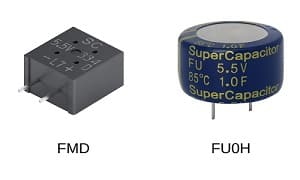They deliver extended lifetime, high power density, fast charging and high reliability at 85°C for energy storage

Supercapacitors for automotive electronics enables freedom from design limitations that gets restricted due to battery lifetimes. Their open-circuit failure mode contrasts with typical short-circuit battery failures that may result in outgassing or ignition. Furthermore, supercapacitors are a cost-effective alternative to small backup batteries.
Depending on the load type and current demand, supercapacitors can store enough energy to provide backup from a few seconds to several hours. They are ideal for maintaining the main power system’s real-time clock or volatile memory when it is removed, such as during a power failure or when the main power system’s battery has been removed for replacement.
Leveraging this, KEMET has released new high-performance supercapacitors for automotive electronics, the FMD and FU0H series that claim to deliver 1,000 hours at 85°C/85% RH-rated voltage and operating temperature ranging from -40°C to 85°C. The FMD series offers the highest lifetime with up to 4,000 hours. These devices are ideal for automotive applications that require a main power system backup during a power loss, such as ADAS, autonomous vehicles and central gateway ECUs. Additionally, these supercapacitors offer power backup in equipment ranging from IoT devices, smart meters, medical devices and industrial computing.
The newly launched supercapacitors by KEMET use a proprietary aqueous electrolyte solution that provides high durability against liquid leakage, vibrations and thermal shock, which is suitable for high reliability in harsh environments. Aqueous electrolytes are highly conductive, have a low environmental impact, and are non-toxic and non-flammable. Unlike a battery, supercapacitors store and release energy quickly through physical adsorption and the ions desorption in the electrolyte between its electrodes. The supercapacitor’s low internal resistance allows these devices to fully charge within a few seconds. In contrast, a secondary battery cell can take from ten minutes to several hours to fully charge. Moreover, these batteries have no theoretical limit to the life cycle, whereas a lithium-ion secondary cell has a finite lifetime of about 500 cycles. They also typically have a greater resistance to moisture absorption than organic compounds, resulting in a longer life with better stability.
According to a report by Allied Market Research, the global supercapacitor market is estimated to reach US$ 16.95 billion by 2027, with a CAGR of 23.3% from 2020 to 2027. All this is possible because of the growing requirement for automotive applications, renewable energy systems and supportive government regulations.
Qualified to an automotive testing protocol, these supercapacitors are manufactured in an ISO TS 16949 certified plant and are subjected to PPAP/PSW and change control.
KEMET supercapacitors are available immediately via KEMET distributors.











Un gran saludo,desde Colombia,gracias,por mantenernos informados,de los últimos descubrimientos y dispositivos modernos.
Gracias por sus valiosos comentarios.